CX770007 - International Marketing Plan for L&P Drinks in China
VerifiedAdded on 2023/06/07
|19
|4865
|147
Report
AI Summary
This report outlines an international marketing strategy for Lemon & Paeroa (L&P) drinks, a New Zealand-based soft drink, focusing on expansion into the Chinese market. It begins with an executive summary highlighting the brand's popularity and the potential for international growth. The report includes a competitor analysis, identifying key players in the Chinese beverage market such as Wahaha Nutri-Express, Fanta, and local tea vendors. It then details a marketing mix strategy tailored for the Chinese market, emphasizing product adaptation, pricing, promotion, and distribution channels. The target market is identified as teenagers interested in fresh, minty flavors. The report also offers recommendations for successful market penetration, considering cultural nuances and consumer preferences in China. Ultimately, the report aims to provide a comprehensive plan for L&P to establish a strong presence in the Chinese beverage industry.
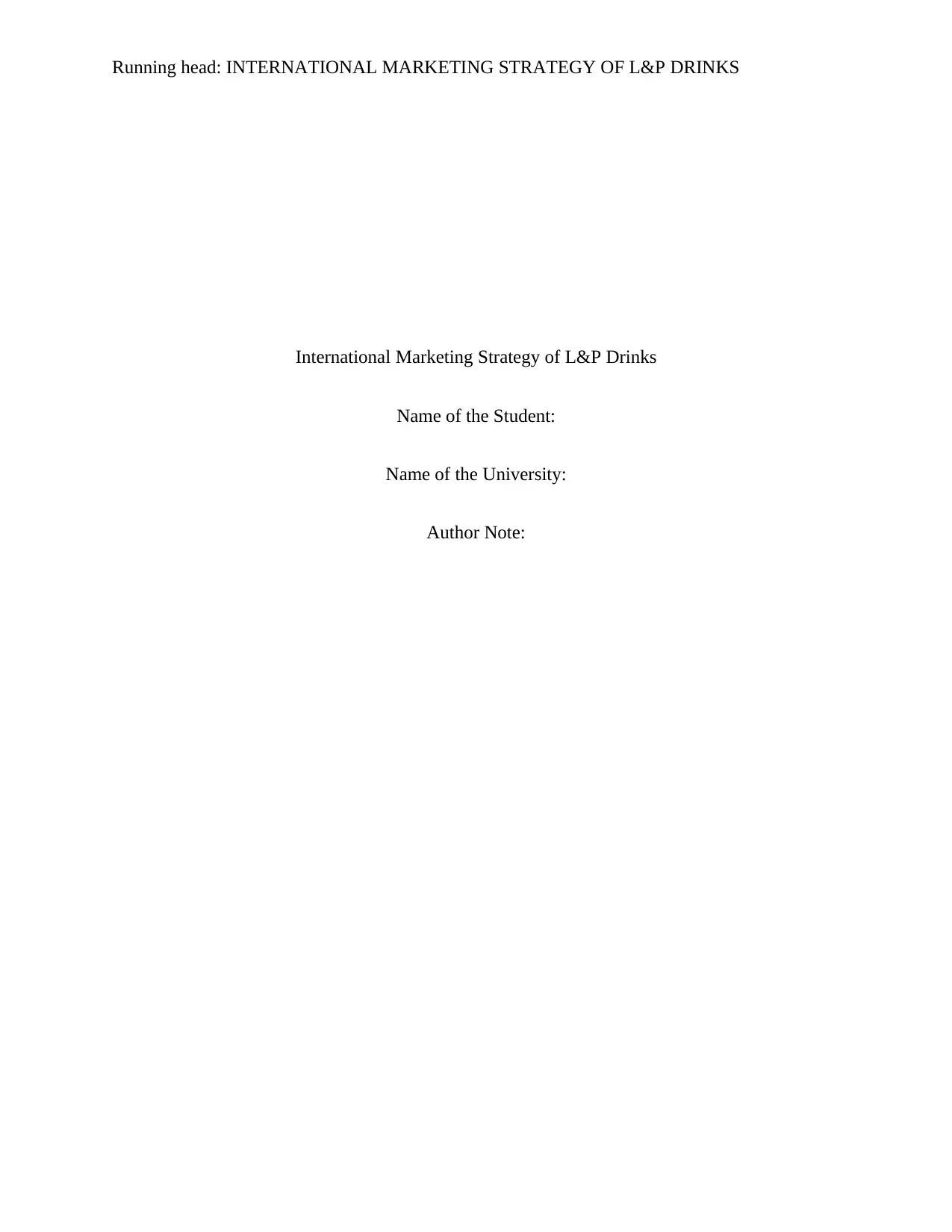
Running head: INTERNATIONAL MARKETING STRATEGY OF L&P DRINKS
International Marketing Strategy of L&P Drinks
Name of the Student:
Name of the University:
Author Note:
International Marketing Strategy of L&P Drinks
Name of the Student:
Name of the University:
Author Note:
Paraphrase This Document
Need a fresh take? Get an instant paraphrase of this document with our AI Paraphraser
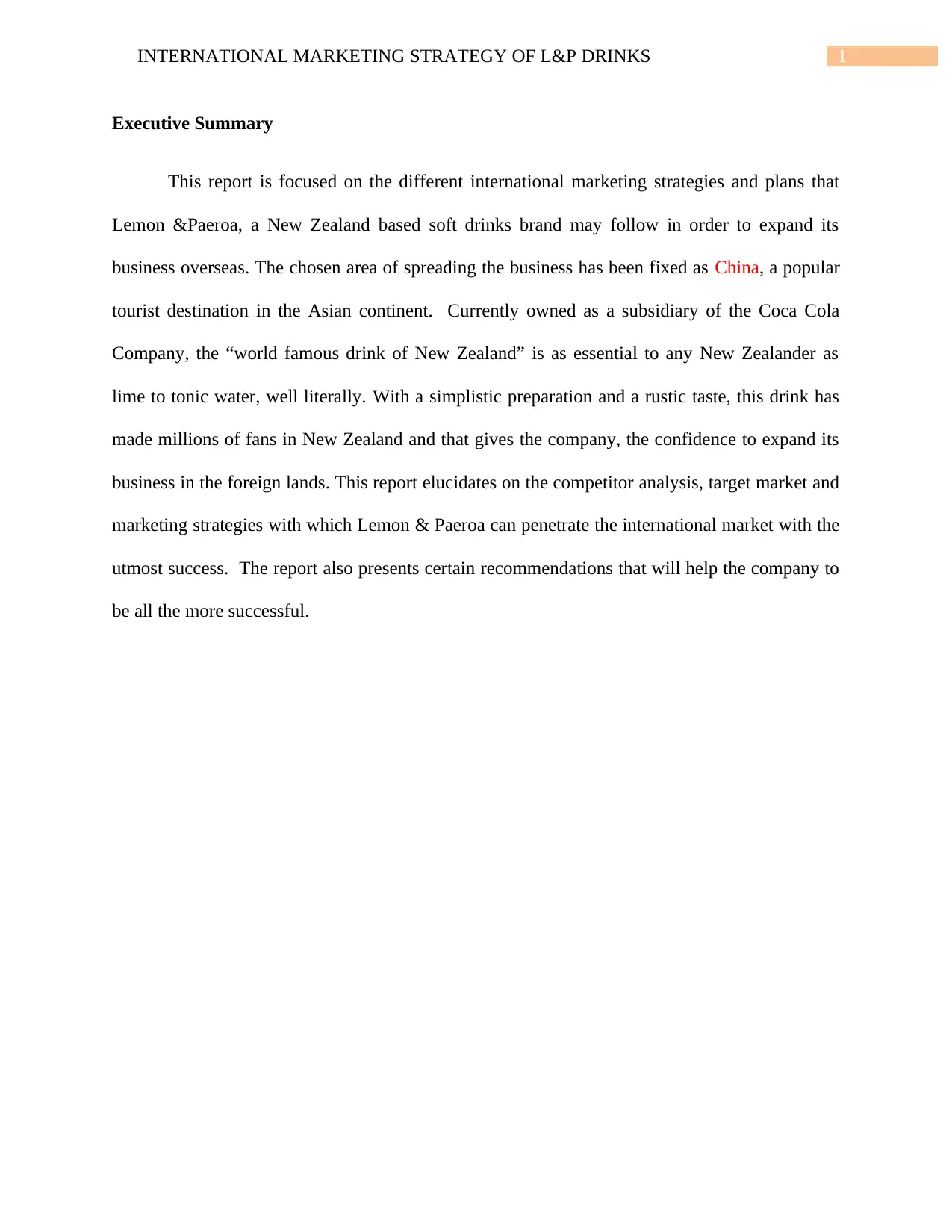
1INTERNATIONAL MARKETING STRATEGY OF L&P DRINKS
Executive Summary
This report is focused on the different international marketing strategies and plans that
Lemon &Paeroa, a New Zealand based soft drinks brand may follow in order to expand its
business overseas. The chosen area of spreading the business has been fixed as China, a popular
tourist destination in the Asian continent. Currently owned as a subsidiary of the Coca Cola
Company, the “world famous drink of New Zealand” is as essential to any New Zealander as
lime to tonic water, well literally. With a simplistic preparation and a rustic taste, this drink has
made millions of fans in New Zealand and that gives the company, the confidence to expand its
business in the foreign lands. This report elucidates on the competitor analysis, target market and
marketing strategies with which Lemon & Paeroa can penetrate the international market with the
utmost success. The report also presents certain recommendations that will help the company to
be all the more successful.
Executive Summary
This report is focused on the different international marketing strategies and plans that
Lemon &Paeroa, a New Zealand based soft drinks brand may follow in order to expand its
business overseas. The chosen area of spreading the business has been fixed as China, a popular
tourist destination in the Asian continent. Currently owned as a subsidiary of the Coca Cola
Company, the “world famous drink of New Zealand” is as essential to any New Zealander as
lime to tonic water, well literally. With a simplistic preparation and a rustic taste, this drink has
made millions of fans in New Zealand and that gives the company, the confidence to expand its
business in the foreign lands. This report elucidates on the competitor analysis, target market and
marketing strategies with which Lemon & Paeroa can penetrate the international market with the
utmost success. The report also presents certain recommendations that will help the company to
be all the more successful.
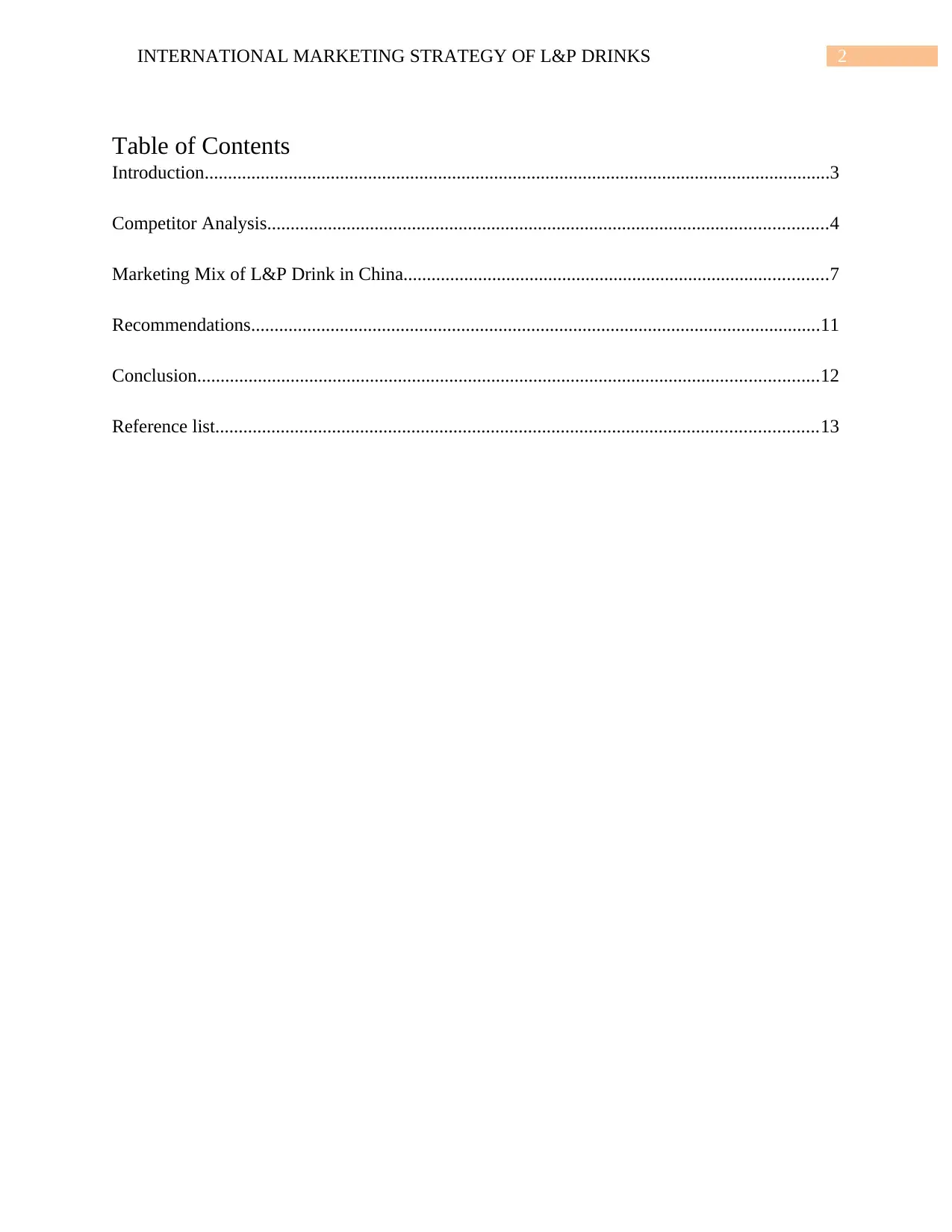
2INTERNATIONAL MARKETING STRATEGY OF L&P DRINKS
Table of Contents
Introduction......................................................................................................................................3
Competitor Analysis........................................................................................................................4
Marketing Mix of L&P Drink in China...........................................................................................7
Recommendations..........................................................................................................................11
Conclusion.....................................................................................................................................12
Reference list.................................................................................................................................13
Table of Contents
Introduction......................................................................................................................................3
Competitor Analysis........................................................................................................................4
Marketing Mix of L&P Drink in China...........................................................................................7
Recommendations..........................................................................................................................11
Conclusion.....................................................................................................................................12
Reference list.................................................................................................................................13
⊘ This is a preview!⊘
Do you want full access?
Subscribe today to unlock all pages.

Trusted by 1+ million students worldwide
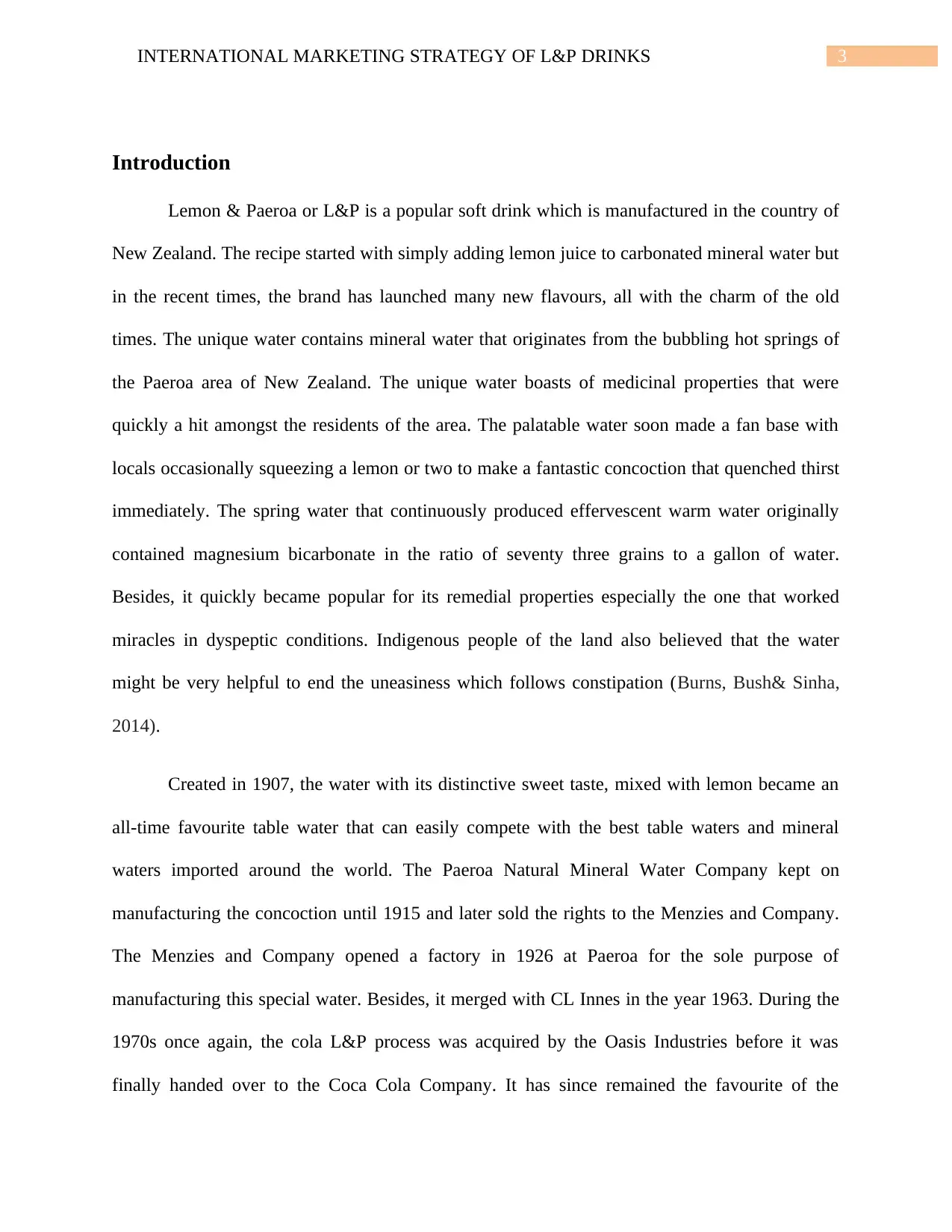
3INTERNATIONAL MARKETING STRATEGY OF L&P DRINKS
Introduction
Lemon & Paeroa or L&P is a popular soft drink which is manufactured in the country of
New Zealand. The recipe started with simply adding lemon juice to carbonated mineral water but
in the recent times, the brand has launched many new flavours, all with the charm of the old
times. The unique water contains mineral water that originates from the bubbling hot springs of
the Paeroa area of New Zealand. The unique water boasts of medicinal properties that were
quickly a hit amongst the residents of the area. The palatable water soon made a fan base with
locals occasionally squeezing a lemon or two to make a fantastic concoction that quenched thirst
immediately. The spring water that continuously produced effervescent warm water originally
contained magnesium bicarbonate in the ratio of seventy three grains to a gallon of water.
Besides, it quickly became popular for its remedial properties especially the one that worked
miracles in dyspeptic conditions. Indigenous people of the land also believed that the water
might be very helpful to end the uneasiness which follows constipation (Burns, Bush& Sinha,
2014).
Created in 1907, the water with its distinctive sweet taste, mixed with lemon became an
all-time favourite table water that can easily compete with the best table waters and mineral
waters imported around the world. The Paeroa Natural Mineral Water Company kept on
manufacturing the concoction until 1915 and later sold the rights to the Menzies and Company.
The Menzies and Company opened a factory in 1926 at Paeroa for the sole purpose of
manufacturing this special water. Besides, it merged with CL Innes in the year 1963. During the
1970s once again, the cola L&P process was acquired by the Oasis Industries before it was
finally handed over to the Coca Cola Company. It has since remained the favourite of the
Introduction
Lemon & Paeroa or L&P is a popular soft drink which is manufactured in the country of
New Zealand. The recipe started with simply adding lemon juice to carbonated mineral water but
in the recent times, the brand has launched many new flavours, all with the charm of the old
times. The unique water contains mineral water that originates from the bubbling hot springs of
the Paeroa area of New Zealand. The unique water boasts of medicinal properties that were
quickly a hit amongst the residents of the area. The palatable water soon made a fan base with
locals occasionally squeezing a lemon or two to make a fantastic concoction that quenched thirst
immediately. The spring water that continuously produced effervescent warm water originally
contained magnesium bicarbonate in the ratio of seventy three grains to a gallon of water.
Besides, it quickly became popular for its remedial properties especially the one that worked
miracles in dyspeptic conditions. Indigenous people of the land also believed that the water
might be very helpful to end the uneasiness which follows constipation (Burns, Bush& Sinha,
2014).
Created in 1907, the water with its distinctive sweet taste, mixed with lemon became an
all-time favourite table water that can easily compete with the best table waters and mineral
waters imported around the world. The Paeroa Natural Mineral Water Company kept on
manufacturing the concoction until 1915 and later sold the rights to the Menzies and Company.
The Menzies and Company opened a factory in 1926 at Paeroa for the sole purpose of
manufacturing this special water. Besides, it merged with CL Innes in the year 1963. During the
1970s once again, the cola L&P process was acquired by the Oasis Industries before it was
finally handed over to the Coca Cola Company. It has since remained the favourite of the
Paraphrase This Document
Need a fresh take? Get an instant paraphrase of this document with our AI Paraphraser
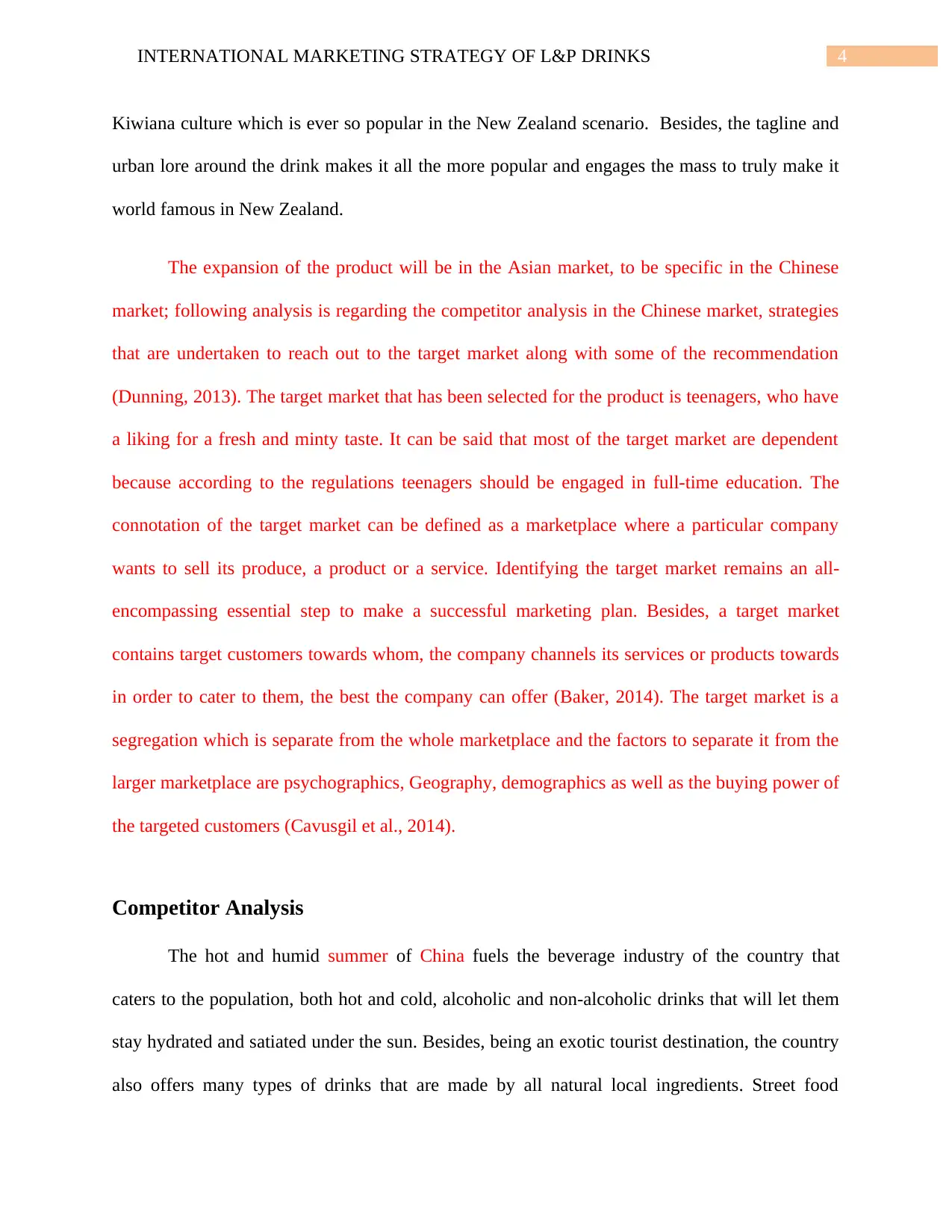
4INTERNATIONAL MARKETING STRATEGY OF L&P DRINKS
Kiwiana culture which is ever so popular in the New Zealand scenario. Besides, the tagline and
urban lore around the drink makes it all the more popular and engages the mass to truly make it
world famous in New Zealand.
The expansion of the product will be in the Asian market, to be specific in the Chinese
market; following analysis is regarding the competitor analysis in the Chinese market, strategies
that are undertaken to reach out to the target market along with some of the recommendation
(Dunning, 2013). The target market that has been selected for the product is teenagers, who have
a liking for a fresh and minty taste. It can be said that most of the target market are dependent
because according to the regulations teenagers should be engaged in full-time education. The
connotation of the target market can be defined as a marketplace where a particular company
wants to sell its produce, a product or a service. Identifying the target market remains an all-
encompassing essential step to make a successful marketing plan. Besides, a target market
contains target customers towards whom, the company channels its services or products towards
in order to cater to them, the best the company can offer (Baker, 2014). The target market is a
segregation which is separate from the whole marketplace and the factors to separate it from the
larger marketplace are psychographics, Geography, demographics as well as the buying power of
the targeted customers (Cavusgil et al., 2014).
Competitor Analysis
The hot and humid summer of China fuels the beverage industry of the country that
caters to the population, both hot and cold, alcoholic and non-alcoholic drinks that will let them
stay hydrated and satiated under the sun. Besides, being an exotic tourist destination, the country
also offers many types of drinks that are made by all natural local ingredients. Street food
Kiwiana culture which is ever so popular in the New Zealand scenario. Besides, the tagline and
urban lore around the drink makes it all the more popular and engages the mass to truly make it
world famous in New Zealand.
The expansion of the product will be in the Asian market, to be specific in the Chinese
market; following analysis is regarding the competitor analysis in the Chinese market, strategies
that are undertaken to reach out to the target market along with some of the recommendation
(Dunning, 2013). The target market that has been selected for the product is teenagers, who have
a liking for a fresh and minty taste. It can be said that most of the target market are dependent
because according to the regulations teenagers should be engaged in full-time education. The
connotation of the target market can be defined as a marketplace where a particular company
wants to sell its produce, a product or a service. Identifying the target market remains an all-
encompassing essential step to make a successful marketing plan. Besides, a target market
contains target customers towards whom, the company channels its services or products towards
in order to cater to them, the best the company can offer (Baker, 2014). The target market is a
segregation which is separate from the whole marketplace and the factors to separate it from the
larger marketplace are psychographics, Geography, demographics as well as the buying power of
the targeted customers (Cavusgil et al., 2014).
Competitor Analysis
The hot and humid summer of China fuels the beverage industry of the country that
caters to the population, both hot and cold, alcoholic and non-alcoholic drinks that will let them
stay hydrated and satiated under the sun. Besides, being an exotic tourist destination, the country
also offers many types of drinks that are made by all natural local ingredients. Street food
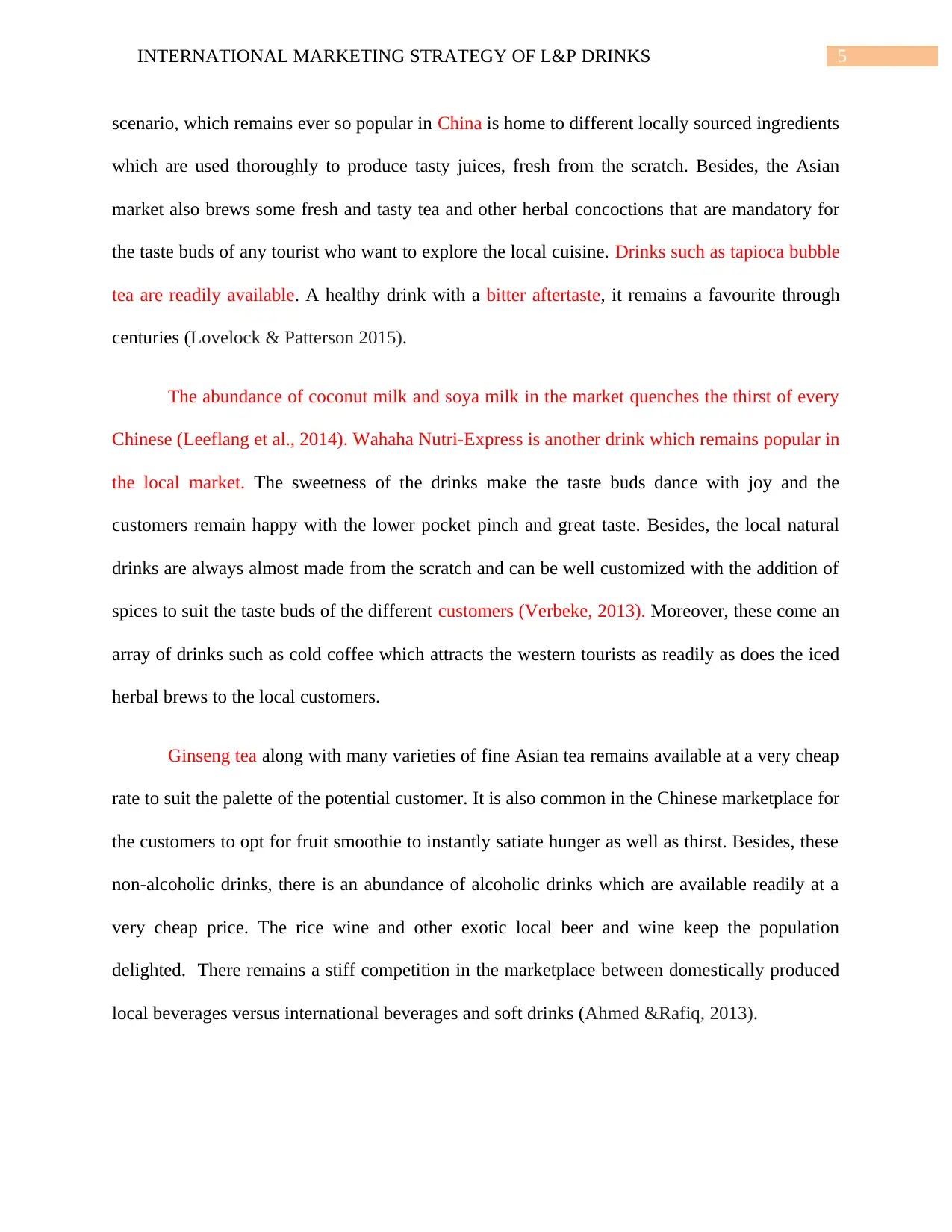
5INTERNATIONAL MARKETING STRATEGY OF L&P DRINKS
scenario, which remains ever so popular in China is home to different locally sourced ingredients
which are used thoroughly to produce tasty juices, fresh from the scratch. Besides, the Asian
market also brews some fresh and tasty tea and other herbal concoctions that are mandatory for
the taste buds of any tourist who want to explore the local cuisine. Drinks such as tapioca bubble
tea are readily available. A healthy drink with a bitter aftertaste, it remains a favourite through
centuries (Lovelock & Patterson 2015).
The abundance of coconut milk and soya milk in the market quenches the thirst of every
Chinese (Leeflang et al., 2014). Wahaha Nutri-Express is another drink which remains popular in
the local market. The sweetness of the drinks make the taste buds dance with joy and the
customers remain happy with the lower pocket pinch and great taste. Besides, the local natural
drinks are always almost made from the scratch and can be well customized with the addition of
spices to suit the taste buds of the different customers (Verbeke, 2013). Moreover, these come an
array of drinks such as cold coffee which attracts the western tourists as readily as does the iced
herbal brews to the local customers.
Ginseng tea along with many varieties of fine Asian tea remains available at a very cheap
rate to suit the palette of the potential customer. It is also common in the Chinese marketplace for
the customers to opt for fruit smoothie to instantly satiate hunger as well as thirst. Besides, these
non-alcoholic drinks, there is an abundance of alcoholic drinks which are available readily at a
very cheap price. The rice wine and other exotic local beer and wine keep the population
delighted. There remains a stiff competition in the marketplace between domestically produced
local beverages versus international beverages and soft drinks (Ahmed &Rafiq, 2013).
scenario, which remains ever so popular in China is home to different locally sourced ingredients
which are used thoroughly to produce tasty juices, fresh from the scratch. Besides, the Asian
market also brews some fresh and tasty tea and other herbal concoctions that are mandatory for
the taste buds of any tourist who want to explore the local cuisine. Drinks such as tapioca bubble
tea are readily available. A healthy drink with a bitter aftertaste, it remains a favourite through
centuries (Lovelock & Patterson 2015).
The abundance of coconut milk and soya milk in the market quenches the thirst of every
Chinese (Leeflang et al., 2014). Wahaha Nutri-Express is another drink which remains popular in
the local market. The sweetness of the drinks make the taste buds dance with joy and the
customers remain happy with the lower pocket pinch and great taste. Besides, the local natural
drinks are always almost made from the scratch and can be well customized with the addition of
spices to suit the taste buds of the different customers (Verbeke, 2013). Moreover, these come an
array of drinks such as cold coffee which attracts the western tourists as readily as does the iced
herbal brews to the local customers.
Ginseng tea along with many varieties of fine Asian tea remains available at a very cheap
rate to suit the palette of the potential customer. It is also common in the Chinese marketplace for
the customers to opt for fruit smoothie to instantly satiate hunger as well as thirst. Besides, these
non-alcoholic drinks, there is an abundance of alcoholic drinks which are available readily at a
very cheap price. The rice wine and other exotic local beer and wine keep the population
delighted. There remains a stiff competition in the marketplace between domestically produced
local beverages versus international beverages and soft drinks (Ahmed &Rafiq, 2013).
⊘ This is a preview!⊘
Do you want full access?
Subscribe today to unlock all pages.

Trusted by 1+ million students worldwide
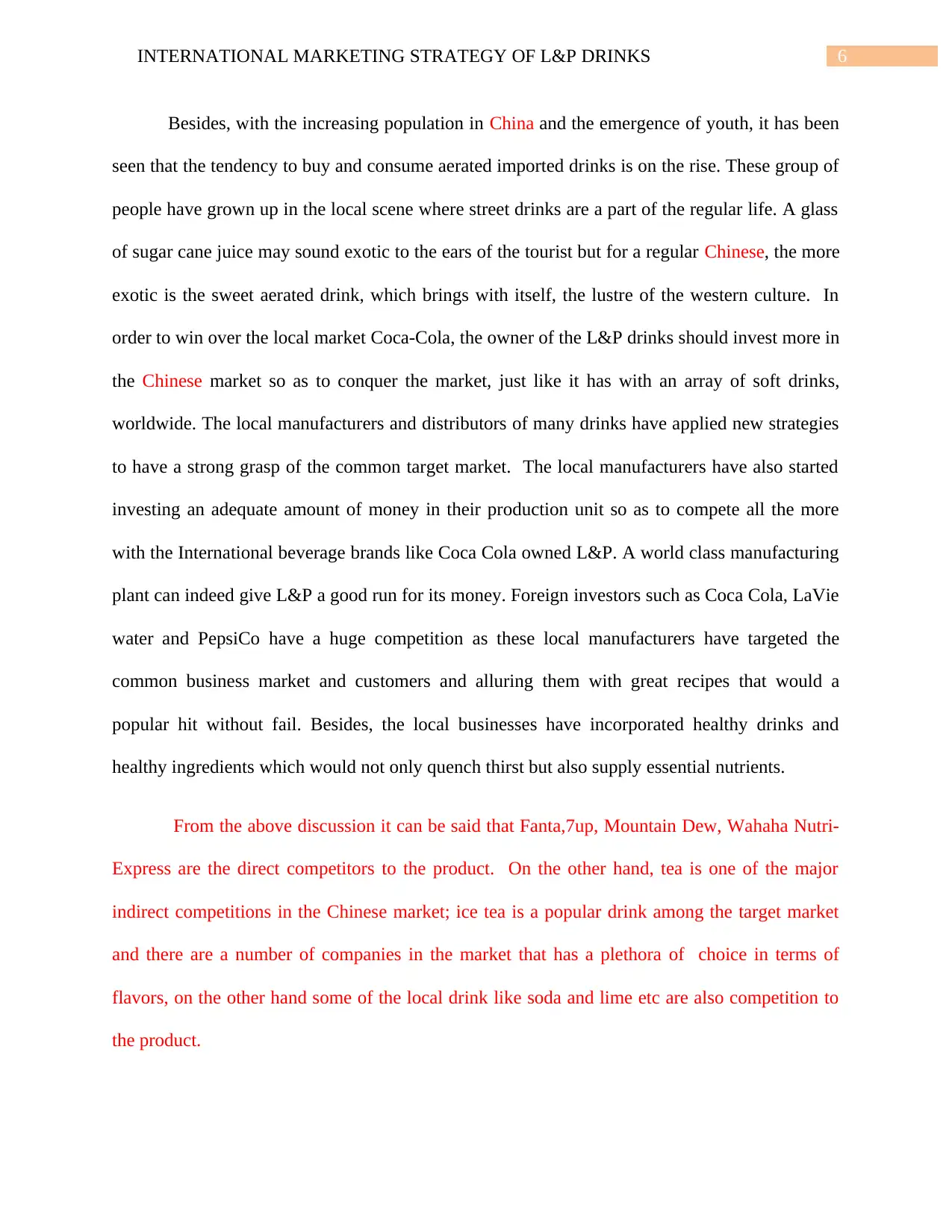
6INTERNATIONAL MARKETING STRATEGY OF L&P DRINKS
Besides, with the increasing population in China and the emergence of youth, it has been
seen that the tendency to buy and consume aerated imported drinks is on the rise. These group of
people have grown up in the local scene where street drinks are a part of the regular life. A glass
of sugar cane juice may sound exotic to the ears of the tourist but for a regular Chinese, the more
exotic is the sweet aerated drink, which brings with itself, the lustre of the western culture. In
order to win over the local market Coca-Cola, the owner of the L&P drinks should invest more in
the Chinese market so as to conquer the market, just like it has with an array of soft drinks,
worldwide. The local manufacturers and distributors of many drinks have applied new strategies
to have a strong grasp of the common target market. The local manufacturers have also started
investing an adequate amount of money in their production unit so as to compete all the more
with the International beverage brands like Coca Cola owned L&P. A world class manufacturing
plant can indeed give L&P a good run for its money. Foreign investors such as Coca Cola, LaVie
water and PepsiCo have a huge competition as these local manufacturers have targeted the
common business market and customers and alluring them with great recipes that would a
popular hit without fail. Besides, the local businesses have incorporated healthy drinks and
healthy ingredients which would not only quench thirst but also supply essential nutrients.
From the above discussion it can be said that Fanta,7up, Mountain Dew, Wahaha Nutri-
Express are the direct competitors to the product. On the other hand, tea is one of the major
indirect competitions in the Chinese market; ice tea is a popular drink among the target market
and there are a number of companies in the market that has a plethora of choice in terms of
flavors, on the other hand some of the local drink like soda and lime etc are also competition to
the product.
Besides, with the increasing population in China and the emergence of youth, it has been
seen that the tendency to buy and consume aerated imported drinks is on the rise. These group of
people have grown up in the local scene where street drinks are a part of the regular life. A glass
of sugar cane juice may sound exotic to the ears of the tourist but for a regular Chinese, the more
exotic is the sweet aerated drink, which brings with itself, the lustre of the western culture. In
order to win over the local market Coca-Cola, the owner of the L&P drinks should invest more in
the Chinese market so as to conquer the market, just like it has with an array of soft drinks,
worldwide. The local manufacturers and distributors of many drinks have applied new strategies
to have a strong grasp of the common target market. The local manufacturers have also started
investing an adequate amount of money in their production unit so as to compete all the more
with the International beverage brands like Coca Cola owned L&P. A world class manufacturing
plant can indeed give L&P a good run for its money. Foreign investors such as Coca Cola, LaVie
water and PepsiCo have a huge competition as these local manufacturers have targeted the
common business market and customers and alluring them with great recipes that would a
popular hit without fail. Besides, the local businesses have incorporated healthy drinks and
healthy ingredients which would not only quench thirst but also supply essential nutrients.
From the above discussion it can be said that Fanta,7up, Mountain Dew, Wahaha Nutri-
Express are the direct competitors to the product. On the other hand, tea is one of the major
indirect competitions in the Chinese market; ice tea is a popular drink among the target market
and there are a number of companies in the market that has a plethora of choice in terms of
flavors, on the other hand some of the local drink like soda and lime etc are also competition to
the product.
Paraphrase This Document
Need a fresh take? Get an instant paraphrase of this document with our AI Paraphraser
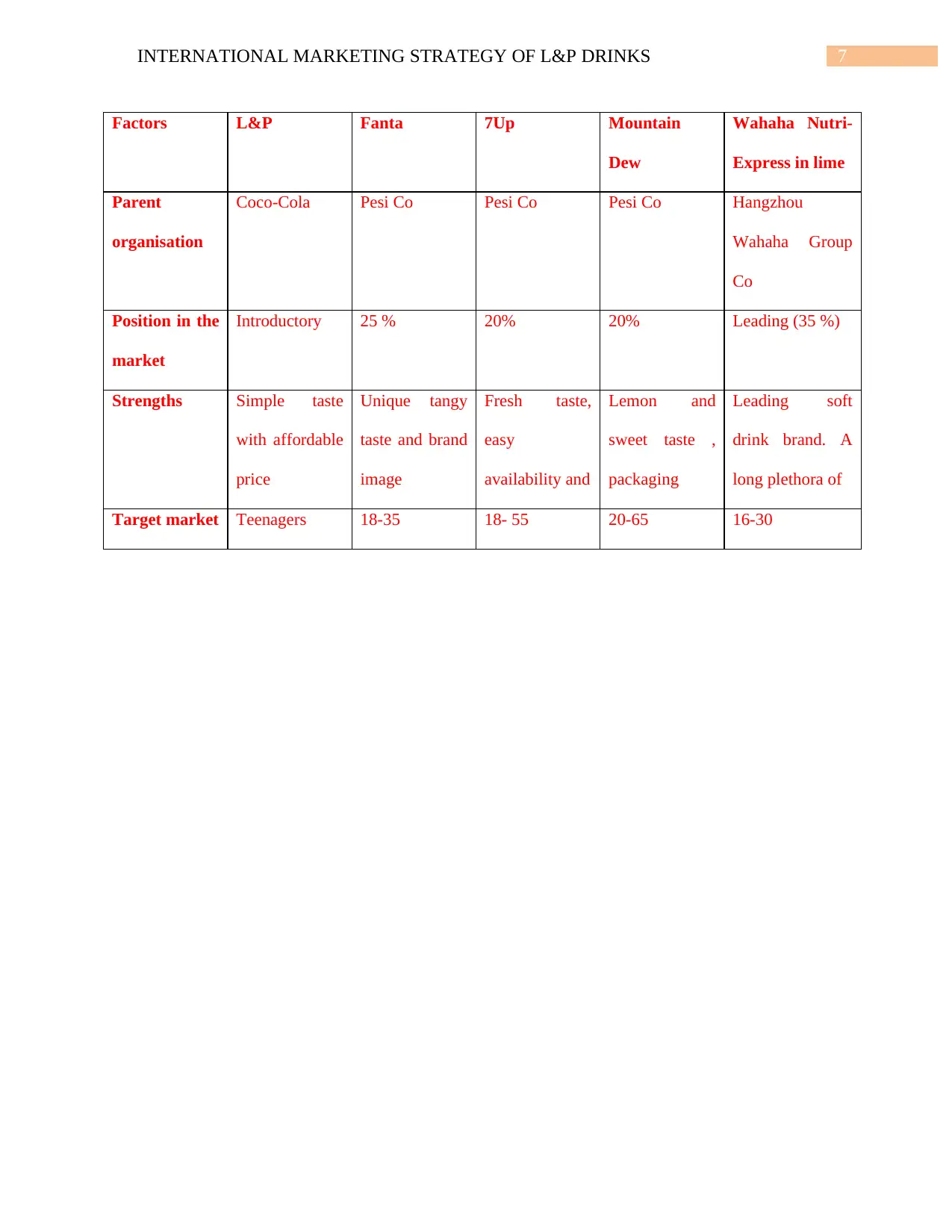
7INTERNATIONAL MARKETING STRATEGY OF L&P DRINKS
Factors L&P Fanta 7Up Mountain
Dew
Wahaha Nutri-
Express in lime
Parent
organisation
Coco-Cola Pesi Co Pesi Co Pesi Co Hangzhou
Wahaha Group
Co
Position in the
market
Introductory 25 % 20% 20% Leading (35 %)
Strengths Simple taste
with affordable
price
Unique tangy
taste and brand
image
Fresh taste,
easy
availability and
Lemon and
sweet taste ,
packaging
Leading soft
drink brand. A
long plethora of
Target market Teenagers 18-35 18- 55 20-65 16-30
Factors L&P Fanta 7Up Mountain
Dew
Wahaha Nutri-
Express in lime
Parent
organisation
Coco-Cola Pesi Co Pesi Co Pesi Co Hangzhou
Wahaha Group
Co
Position in the
market
Introductory 25 % 20% 20% Leading (35 %)
Strengths Simple taste
with affordable
price
Unique tangy
taste and brand
image
Fresh taste,
easy
availability and
Lemon and
sweet taste ,
packaging
Leading soft
drink brand. A
long plethora of
Target market Teenagers 18-35 18- 55 20-65 16-30
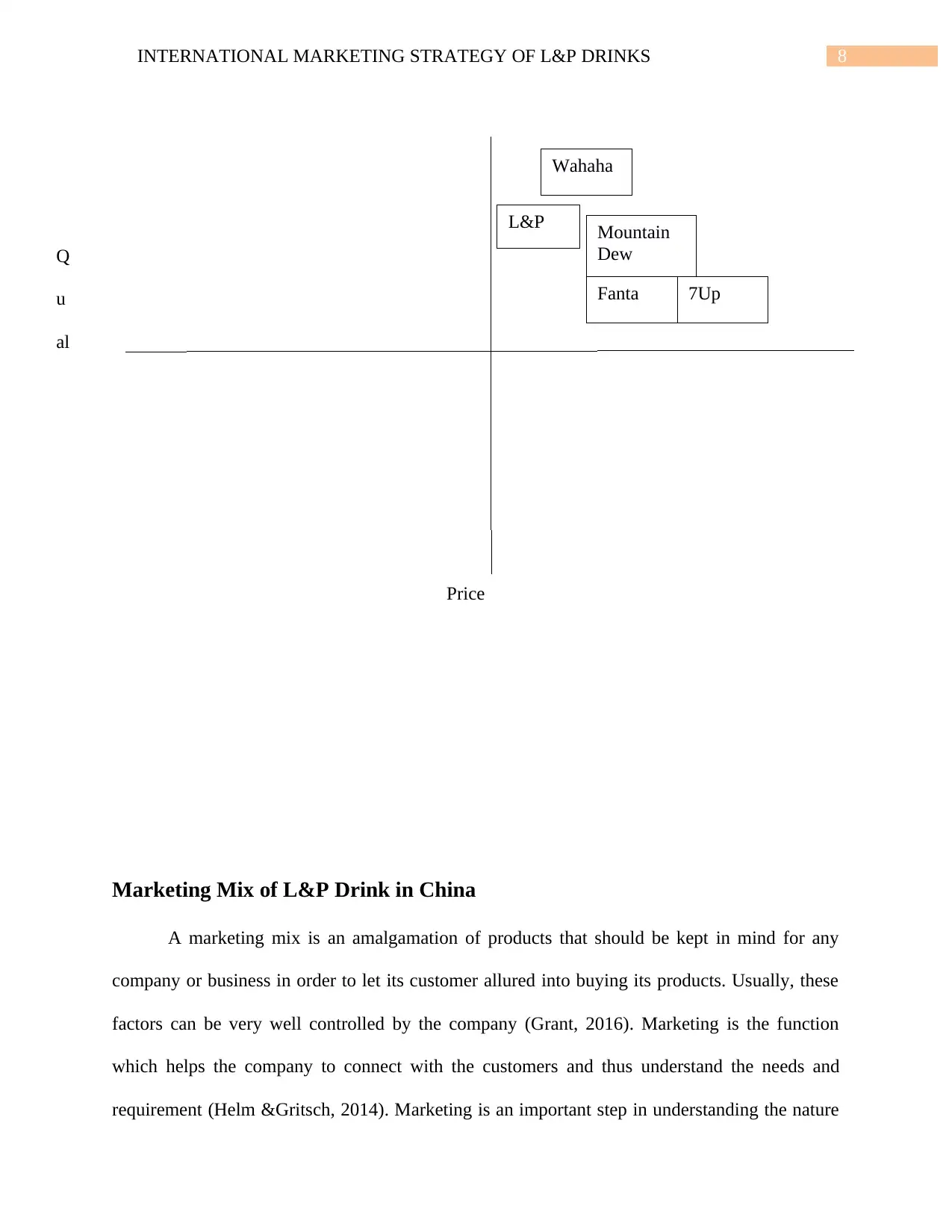
8INTERNATIONAL MARKETING STRATEGY OF L&P DRINKS
L&P Mountain
Dew
7UpFanta
Wahaha
Marketing Mix of L&P Drink in China
A marketing mix is an amalgamation of products that should be kept in mind for any
company or business in order to let its customer allured into buying its products. Usually, these
factors can be very well controlled by the company (Grant, 2016). Marketing is the function
which helps the company to connect with the customers and thus understand the needs and
requirement (Helm &Gritsch, 2014). Marketing is an important step in understanding the nature
Price
Q
u
al
it
L&P Mountain
Dew
7UpFanta
Wahaha
Marketing Mix of L&P Drink in China
A marketing mix is an amalgamation of products that should be kept in mind for any
company or business in order to let its customer allured into buying its products. Usually, these
factors can be very well controlled by the company (Grant, 2016). Marketing is the function
which helps the company to connect with the customers and thus understand the needs and
requirement (Helm &Gritsch, 2014). Marketing is an important step in understanding the nature
Price
Q
u
al
it
⊘ This is a preview!⊘
Do you want full access?
Subscribe today to unlock all pages.

Trusted by 1+ million students worldwide
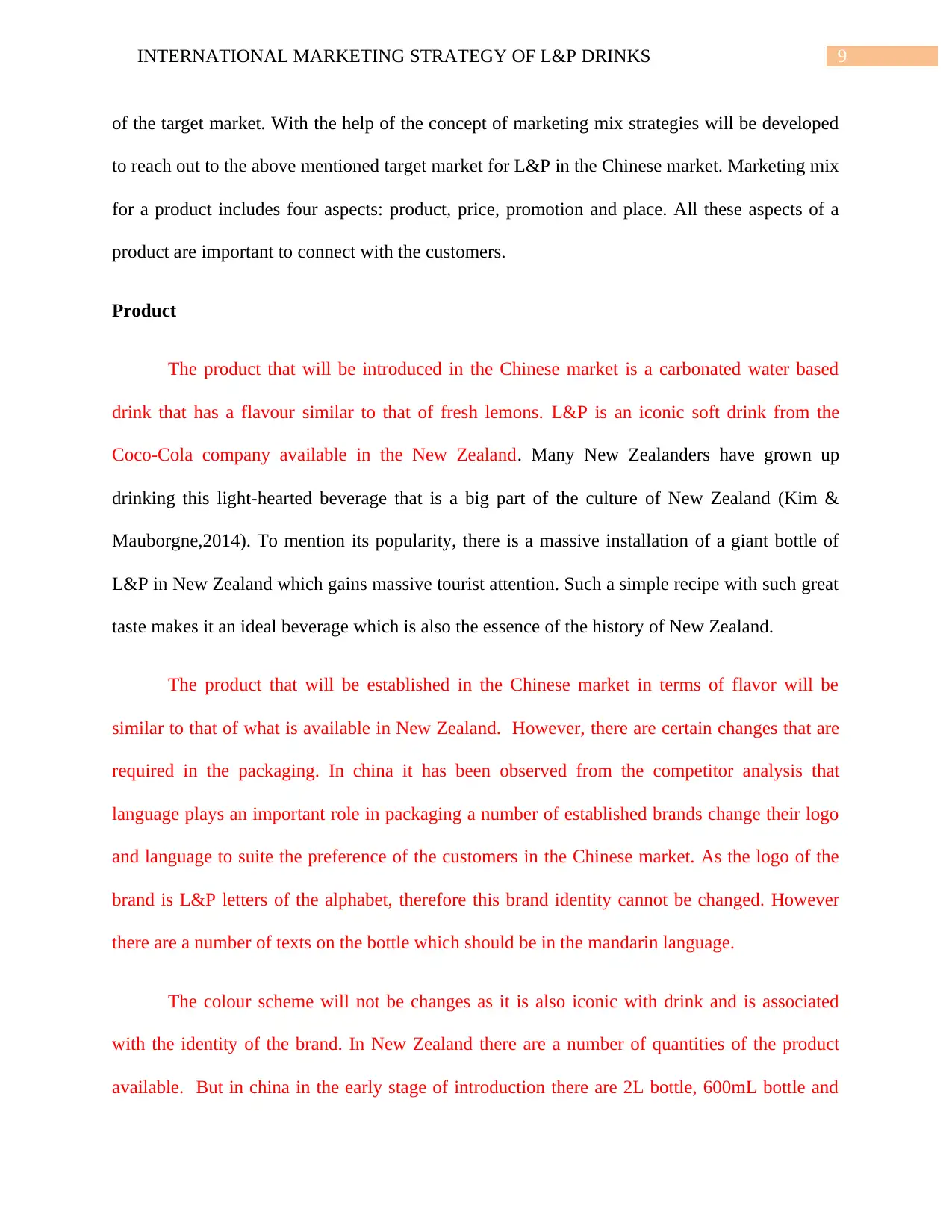
9INTERNATIONAL MARKETING STRATEGY OF L&P DRINKS
of the target market. With the help of the concept of marketing mix strategies will be developed
to reach out to the above mentioned target market for L&P in the Chinese market. Marketing mix
for a product includes four aspects: product, price, promotion and place. All these aspects of a
product are important to connect with the customers.
Product
The product that will be introduced in the Chinese market is a carbonated water based
drink that has a flavour similar to that of fresh lemons. L&P is an iconic soft drink from the
Coco-Cola company available in the New Zealand. Many New Zealanders have grown up
drinking this light-hearted beverage that is a big part of the culture of New Zealand (Kim &
Mauborgne,2014). To mention its popularity, there is a massive installation of a giant bottle of
L&P in New Zealand which gains massive tourist attention. Such a simple recipe with such great
taste makes it an ideal beverage which is also the essence of the history of New Zealand.
The product that will be established in the Chinese market in terms of flavor will be
similar to that of what is available in New Zealand. However, there are certain changes that are
required in the packaging. In china it has been observed from the competitor analysis that
language plays an important role in packaging a number of established brands change their logo
and language to suite the preference of the customers in the Chinese market. As the logo of the
brand is L&P letters of the alphabet, therefore this brand identity cannot be changed. However
there are a number of texts on the bottle which should be in the mandarin language.
The colour scheme will not be changes as it is also iconic with drink and is associated
with the identity of the brand. In New Zealand there are a number of quantities of the product
available. But in china in the early stage of introduction there are 2L bottle, 600mL bottle and
of the target market. With the help of the concept of marketing mix strategies will be developed
to reach out to the above mentioned target market for L&P in the Chinese market. Marketing mix
for a product includes four aspects: product, price, promotion and place. All these aspects of a
product are important to connect with the customers.
Product
The product that will be introduced in the Chinese market is a carbonated water based
drink that has a flavour similar to that of fresh lemons. L&P is an iconic soft drink from the
Coco-Cola company available in the New Zealand. Many New Zealanders have grown up
drinking this light-hearted beverage that is a big part of the culture of New Zealand (Kim &
Mauborgne,2014). To mention its popularity, there is a massive installation of a giant bottle of
L&P in New Zealand which gains massive tourist attention. Such a simple recipe with such great
taste makes it an ideal beverage which is also the essence of the history of New Zealand.
The product that will be established in the Chinese market in terms of flavor will be
similar to that of what is available in New Zealand. However, there are certain changes that are
required in the packaging. In china it has been observed from the competitor analysis that
language plays an important role in packaging a number of established brands change their logo
and language to suite the preference of the customers in the Chinese market. As the logo of the
brand is L&P letters of the alphabet, therefore this brand identity cannot be changed. However
there are a number of texts on the bottle which should be in the mandarin language.
The colour scheme will not be changes as it is also iconic with drink and is associated
with the identity of the brand. In New Zealand there are a number of quantities of the product
available. But in china in the early stage of introduction there are 2L bottle, 600mL bottle and
Paraphrase This Document
Need a fresh take? Get an instant paraphrase of this document with our AI Paraphraser
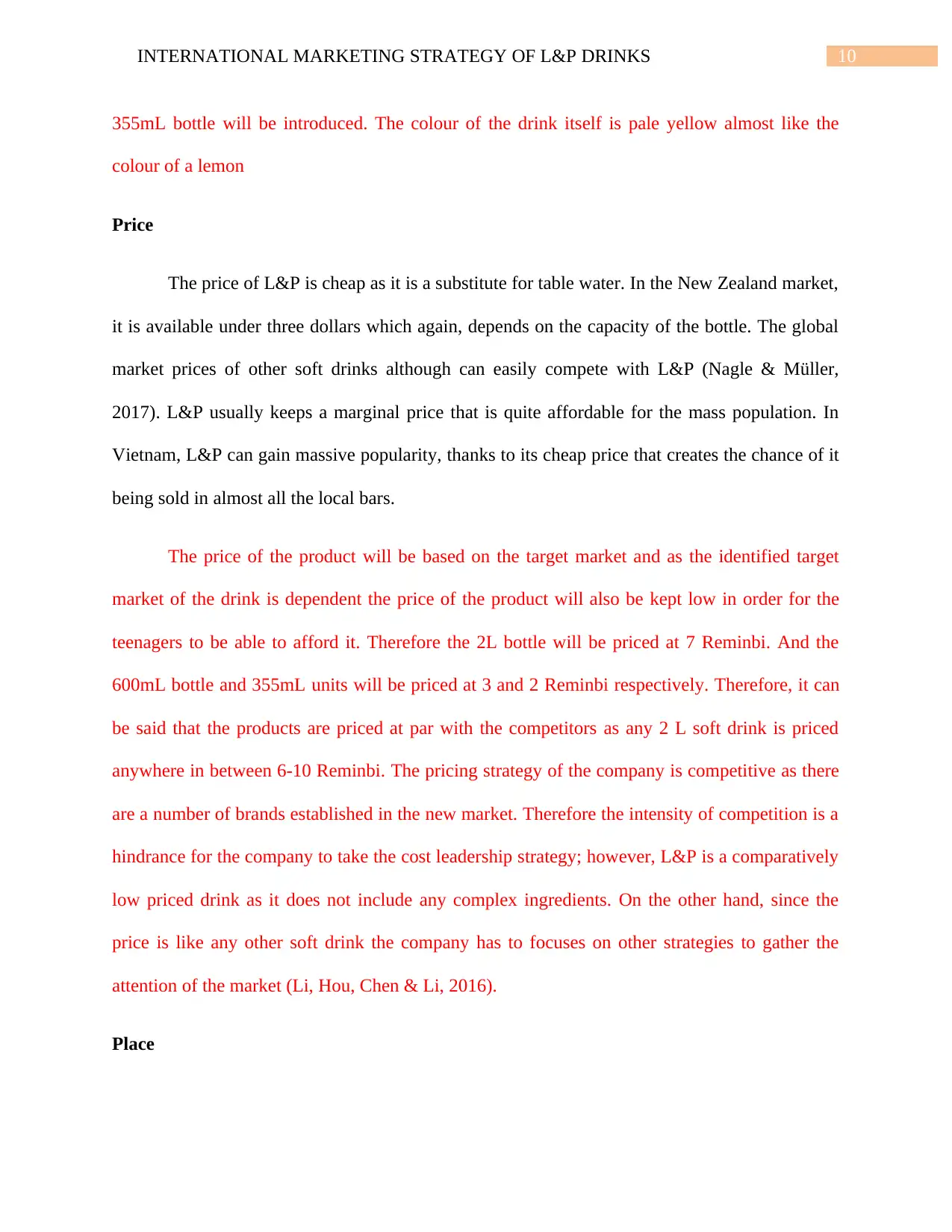
10INTERNATIONAL MARKETING STRATEGY OF L&P DRINKS
355mL bottle will be introduced. The colour of the drink itself is pale yellow almost like the
colour of a lemon
Price
The price of L&P is cheap as it is a substitute for table water. In the New Zealand market,
it is available under three dollars which again, depends on the capacity of the bottle. The global
market prices of other soft drinks although can easily compete with L&P (Nagle & Müller,
2017). L&P usually keeps a marginal price that is quite affordable for the mass population. In
Vietnam, L&P can gain massive popularity, thanks to its cheap price that creates the chance of it
being sold in almost all the local bars.
The price of the product will be based on the target market and as the identified target
market of the drink is dependent the price of the product will also be kept low in order for the
teenagers to be able to afford it. Therefore the 2L bottle will be priced at 7 Reminbi. And the
600mL bottle and 355mL units will be priced at 3 and 2 Reminbi respectively. Therefore, it can
be said that the products are priced at par with the competitors as any 2 L soft drink is priced
anywhere in between 6-10 Reminbi. The pricing strategy of the company is competitive as there
are a number of brands established in the new market. Therefore the intensity of competition is a
hindrance for the company to take the cost leadership strategy; however, L&P is a comparatively
low priced drink as it does not include any complex ingredients. On the other hand, since the
price is like any other soft drink the company has to focuses on other strategies to gather the
attention of the market (Li, Hou, Chen & Li, 2016).
Place
355mL bottle will be introduced. The colour of the drink itself is pale yellow almost like the
colour of a lemon
Price
The price of L&P is cheap as it is a substitute for table water. In the New Zealand market,
it is available under three dollars which again, depends on the capacity of the bottle. The global
market prices of other soft drinks although can easily compete with L&P (Nagle & Müller,
2017). L&P usually keeps a marginal price that is quite affordable for the mass population. In
Vietnam, L&P can gain massive popularity, thanks to its cheap price that creates the chance of it
being sold in almost all the local bars.
The price of the product will be based on the target market and as the identified target
market of the drink is dependent the price of the product will also be kept low in order for the
teenagers to be able to afford it. Therefore the 2L bottle will be priced at 7 Reminbi. And the
600mL bottle and 355mL units will be priced at 3 and 2 Reminbi respectively. Therefore, it can
be said that the products are priced at par with the competitors as any 2 L soft drink is priced
anywhere in between 6-10 Reminbi. The pricing strategy of the company is competitive as there
are a number of brands established in the new market. Therefore the intensity of competition is a
hindrance for the company to take the cost leadership strategy; however, L&P is a comparatively
low priced drink as it does not include any complex ingredients. On the other hand, since the
price is like any other soft drink the company has to focuses on other strategies to gather the
attention of the market (Li, Hou, Chen & Li, 2016).
Place
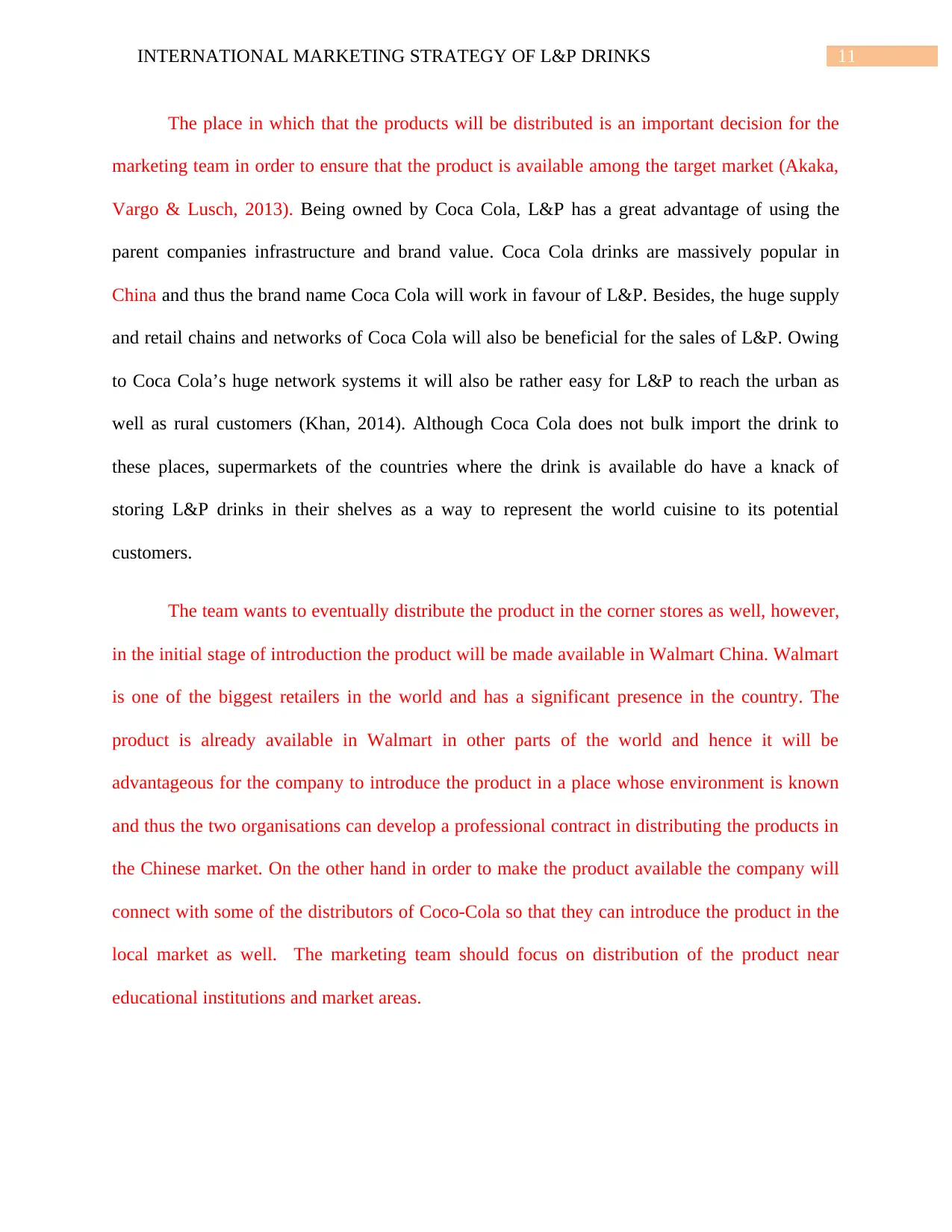
11INTERNATIONAL MARKETING STRATEGY OF L&P DRINKS
The place in which that the products will be distributed is an important decision for the
marketing team in order to ensure that the product is available among the target market (Akaka,
Vargo & Lusch, 2013). Being owned by Coca Cola, L&P has a great advantage of using the
parent companies infrastructure and brand value. Coca Cola drinks are massively popular in
China and thus the brand name Coca Cola will work in favour of L&P. Besides, the huge supply
and retail chains and networks of Coca Cola will also be beneficial for the sales of L&P. Owing
to Coca Cola’s huge network systems it will also be rather easy for L&P to reach the urban as
well as rural customers (Khan, 2014). Although Coca Cola does not bulk import the drink to
these places, supermarkets of the countries where the drink is available do have a knack of
storing L&P drinks in their shelves as a way to represent the world cuisine to its potential
customers.
The team wants to eventually distribute the product in the corner stores as well, however,
in the initial stage of introduction the product will be made available in Walmart China. Walmart
is one of the biggest retailers in the world and has a significant presence in the country. The
product is already available in Walmart in other parts of the world and hence it will be
advantageous for the company to introduce the product in a place whose environment is known
and thus the two organisations can develop a professional contract in distributing the products in
the Chinese market. On the other hand in order to make the product available the company will
connect with some of the distributors of Coco-Cola so that they can introduce the product in the
local market as well. The marketing team should focus on distribution of the product near
educational institutions and market areas.
The place in which that the products will be distributed is an important decision for the
marketing team in order to ensure that the product is available among the target market (Akaka,
Vargo & Lusch, 2013). Being owned by Coca Cola, L&P has a great advantage of using the
parent companies infrastructure and brand value. Coca Cola drinks are massively popular in
China and thus the brand name Coca Cola will work in favour of L&P. Besides, the huge supply
and retail chains and networks of Coca Cola will also be beneficial for the sales of L&P. Owing
to Coca Cola’s huge network systems it will also be rather easy for L&P to reach the urban as
well as rural customers (Khan, 2014). Although Coca Cola does not bulk import the drink to
these places, supermarkets of the countries where the drink is available do have a knack of
storing L&P drinks in their shelves as a way to represent the world cuisine to its potential
customers.
The team wants to eventually distribute the product in the corner stores as well, however,
in the initial stage of introduction the product will be made available in Walmart China. Walmart
is one of the biggest retailers in the world and has a significant presence in the country. The
product is already available in Walmart in other parts of the world and hence it will be
advantageous for the company to introduce the product in a place whose environment is known
and thus the two organisations can develop a professional contract in distributing the products in
the Chinese market. On the other hand in order to make the product available the company will
connect with some of the distributors of Coco-Cola so that they can introduce the product in the
local market as well. The marketing team should focus on distribution of the product near
educational institutions and market areas.
⊘ This is a preview!⊘
Do you want full access?
Subscribe today to unlock all pages.

Trusted by 1+ million students worldwide
1 out of 19
Your All-in-One AI-Powered Toolkit for Academic Success.
+13062052269
info@desklib.com
Available 24*7 on WhatsApp / Email
![[object Object]](/_next/static/media/star-bottom.7253800d.svg)
Unlock your academic potential
Copyright © 2020–2025 A2Z Services. All Rights Reserved. Developed and managed by ZUCOL.
